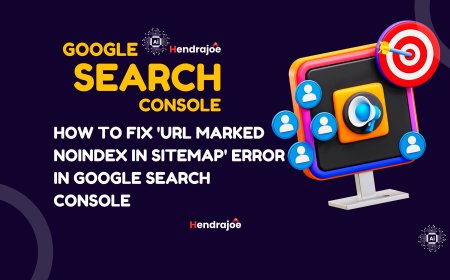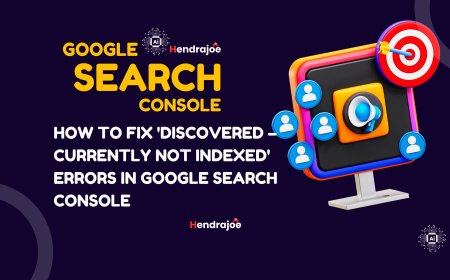Fixing 'Crawled – Currently Not Indexed' Coverage Errors in Google Search Console
Discover how to fix 'Crawled – Currently Not Indexed' errors in Google Search Console. Learn about the causes and solutions to improve your page indexing and SEO performance.

When you're monitoring the health of your website in Google Search Console (GSC), encountering the “Crawled – Currently Not Indexed” error can be frustrating. This issue means that Googlebot has crawled a page on your site but has not yet indexed it. Since indexing is critical for a page to appear in search results, pages that are "crawled but not indexed" may not contribute to your site's SEO rankings.
In this article, we’ll explain what the “Crawled – Currently Not Indexed” error means, why it occurs, and how to fix it. By addressing this issue, you can help ensure that your important pages are indexed and visible in search results, boosting your website’s overall SEO health.
What Does 'Crawled – Currently Not Indexed' Mean?
The “Crawled – Currently Not Indexed” error in Google Search Console occurs when Googlebot has crawled a URL on your site but has chosen not to index it. Even though the page is discovered and crawled, it won’t appear in Google's index, meaning it won’t show up in search engine results.
When this happens, Googlebot recognizes that the page exists, but for some reason, it has decided that the page should not be included in the search index, and thus, it won't appear in search results.
The Crawled – Currently Not Indexed error typically appears in the Coverage section of Google Search Console under the Excluded tab. While this might not seem like a major issue, it could impact your site's SEO, as pages that aren't indexed won't contribute to organic traffic.
Why Does the 'Crawled – Currently Not Indexed' Error Occur?
There are several reasons why a page may be crawled but not indexed. Understanding these causes will help you identify the best solutions to resolve the issue.
1. Low-Quality or Thin Content
Google prioritizes high-quality, useful content when indexing pages. If a page is considered to have thin content (i.e., very little information or substance), Google may choose not to index it, even though it’s crawled.
Example:
- A product page with just a few sentences of description or a landing page with minimal text might not be indexed by Google.
2. Duplicate Content
Google tries to avoid indexing duplicate content in order to offer a better user experience. If a page’s content is too similar to other pages on your site or on other websites, Google might choose not to index it.
Example:
- Multiple pages with nearly identical content, such as duplicate product pages or multiple versions of the same content, could lead to indexing issues.
3. Server or Crawl Budget Issues
If your website is large and has many pages, Googlebot might prioritize crawling important pages, leaving some pages uncrawled or unindexed due to crawl budget limitations. While the pages are crawled, they might not be indexed if Googlebot doesn’t deem them important enough.
Example:
- Pages buried deep in the site structure or pages with minimal internal links might be discovered but not indexed.
4. Technical Issues (Meta Tags, Robots.txt, HTTP Response Codes)
Technical issues can also cause Google to crawl a page but not index it. Incorrect meta tags, such as noindex tags, or issues with robots.txt files can prevent pages from being indexed, even though Googlebot crawls them.
Example:
- A page that has a noindex meta tag will be crawled but will not be indexed, as it is explicitly told not to appear in the index.
5. Recent Page Updates or Changes
If a page has recently been updated or restructured, Google may take time to re-evaluate it before deciding to index it. This could cause a delay in indexing, even though Googlebot has already crawled the updated page.
Example:
- A recently modified page might be crawled, but Google might need extra time to review the changes and determine if the page is worth indexing.
6. Low-Value or Orphan Pages
Google is less likely to index pages that it considers low value or orphan pages (pages with no internal links pointing to them). These pages may be discovered by Googlebot but are unlikely to be indexed if they don’t provide sufficient value or are hard to find.
Example:
- A blog post buried deep in your site without any internal links pointing to it might be crawled but not indexed.
How to Fix 'Crawled – Currently Not Indexed' Errors
If you're seeing “Crawled – Currently Not Indexed” errors in Google Search Console, here are several steps you can take to resolve the issue and get your pages indexed.
1. Improve Content Quality
One of the main reasons pages are not indexed is because they have thin or low-quality content. To improve the chances of your page being indexed:
- Add more valuable content: Ensure that your pages provide detailed, useful, and original content that will be useful to your target audience.
- Focus on uniqueness: Avoid content duplication across your site. If multiple pages contain similar content, consolidate them into one page or use canonical tags to indicate the preferred version for indexing.
2. Resolve Duplicate Content Issues
If duplicate content is preventing indexing, take action to make sure Google indexes the most important page:
- Use canonical tags: If you have multiple pages with similar content, make sure you add rel=canonical tags to point to the main version of the content.
- Consolidate duplicate pages: Where possible, merge similar pages to eliminate redundancy. Google will index one authoritative page rather than multiple similar pages.
3. Improve Crawl Budget Management
If your site is large or has complex internal linking, you may face crawl budget issues. To ensure important pages are crawled and indexed:
- Prioritize internal linking: Use internal links to make sure that Googlebot can easily discover important pages. Focus on linking to key pages from high-traffic or important pages like the homepage.
- Update your sitemap: Ensure your XML sitemap is up to date and includes all pages you want Google to index. Submit your updated sitemap in Google Search Console.
4. Fix Technical Issues
Sometimes, technical issues prevent Google from indexing a page, even though it’s crawled. Here’s what you can do to fix it:
- Check for noindex meta tags: Ensure that the pages you want indexed don’t have a noindex meta tag. You can use URL Inspection Tool in GSC to check this.
- Review your robots.txt file: Make sure your robots.txt file isn’t blocking Googlebot from crawling important pages.
- Fix server errors: Ensure the pages return the correct 200 OK status code and not a 404 or 403 error.
5. Increase Internal Linking
If the pages in question aren’t linked to from other pages, Google might not prioritize indexing them. To solve this:
- Add internal links: Link to important pages from other relevant pages across your site. This will help Googlebot find and index these pages more easily.
- Create a clear site structure: Ensure that your site has a logical and organized structure so that Googlebot can crawl and index pages more effectively.
6. Be Patient and Monitor Changes
Sometimes, a page may not be indexed immediately after it is crawled. Google may need more time to evaluate the page or check for content quality. Here’s how to proceed:
- Request indexing: After making improvements, use the URL Inspection Tool in GSC to request re-indexing of the page.
- Wait for Googlebot to review: If the page is newly updated, be patient and allow Googlebot to re-crawl it before taking further action.
7. Check for Orphan Pages
If the pages are orphan pages (pages with no internal links pointing to them), Google might crawl them but not index them. To fix this:
- Link to the page from other relevant pages: Ensure that other pages on your site link to the pages that are crawled but not indexed.
Conclusion
The “Crawled – Currently Not Indexed” error in Google Search Console can be frustrating, but with the right approach, it’s possible to resolve it and get your pages indexed. By improving content quality, resolving technical issues, managing crawl budget, and ensuring proper internal linking, you can boost the chances of your pages being indexed by Google.
If you have any questions or need further assistance in fixing the “Crawled – Currently Not Indexed” errors on your website, feel free to leave a comment below. And don’t forget to visit my website regularly for the latest updates on SEO and website optimization!
What's Your Reaction?









































